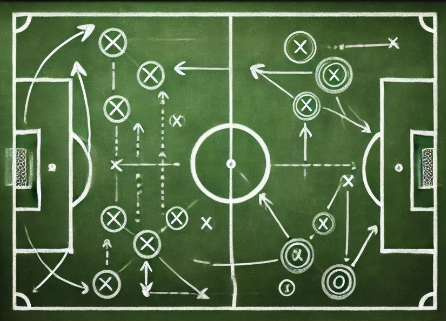
In the world of football, risk assessment is an integral part of the strategy that can determine the outcomes of matches and seasons. This article explores how professional teams utilise complex tactical decisions to maximise their chances of success. We will look at how analytical approaches and cutting-edge technologies assist managers and players in managing risks on the pitch, as well as how principles of risk management in sport are applicable in everyday life.
Understanding the analysed risks in football
Mitigated risks in football require coaches and players to engage in strategic planning at all stages of the game—from preparation to real-time decision-making on the pitch. This encompasses everything from selecting the squad to making substitution decisions at critical moments, where each choice can radically alter the outcome of the match.
Betting on sports in casinos and bookmakers highlights similar risks, where each decision is based on analysis and strategy. Many online casinos, which also offer bookmaking functions, provide a unique perspective on risk management. Detailed reviews of such platforms and their strategies are available on the website casino-sistersite.co.uk.
Strategic risk management in professional football
Strategic risk management plays a critical role in the success of football teams. It requires coaches and players to have not only a deep understanding of tactics but also the ability to quickly adapt to changing conditions on the pitch. In the following sections, we will explore how teams employ various strategic approaches to minimise risks and maximise opportunities for victory.
-
Developing tactical plans: The foundation of strategic risk management lies in creating effective tactical plans that take into account both the strengths and weaknesses of one’s own team as well as those of the opponents.
-
Making quick decisions: A crucial element is the coach’s ability to make swift and effective decisions during a match, based on the current state of play and the opponent’s behaviour.
-
Post-match analysis: The analysis following a match helps teams identify mistakes and successes in order to improve strategies and preparation for future games.
-
Player management: Effective risk management not only involves tactical preparation but also managing the condition of players, their physical fitness, and morale.
Tactical adjustments during the match

Tactical changes on the pitch often decide the outcome of a match. For example, in the match against Chelsea, the Manchester City manager switched the tactical formation from 4-3-3 to 3-4-3, which allowed for a stronger attack at the expense of defence. The Impact of Modern Technologies on Football significantly raises the stakes, demanding from coaches not only analytical thinking but also an assessment of the potential and current state of players.
Risky Substitutions: Risk versus Reward
Substitutions at critical moments of the game can dramatically change its course. One such example occurred during a Champions League match in May 2022, when Real Madrid’s manager, Carlo Ancelotti, brought on Rodrygo in the final minutes against Manchester City. The Brazilian scored two goals towards the end of the match, allowing Real Madrid to pull off an incredible comeback and advance to the tournament’s final. Although this move increased their vulnerability in defence, it also opened up new opportunities for attack and ultimately paid off.
Adaptation to opponents’ strategies
Effective risk management involves adapting to the changing strategies of opponents. Analysing the opposition’s play, anticipating their moves, and accordingly adjusting one’s own tactics can significantly increase the chances of success. For instance, the response of Barcelona’s coach to Real Madrid’s pressure, by bolstering the midfield with an additional midfielder, allowed them to control the pace of the game and prevent dangerous attacks from the opposition.
Taking Risks in Football: A Case Study
Analysis of case studies from recent football matches demonstrates how professional teams make risky decisions that affect the outcomes of games. Particular attention is paid to decisions that lead to significant changes in the game, both positive and negative.
Recent matches and their outcomes:
- Arsenal’s game against Chelsea saw the Arsenal manager switch tactics from 5-3-2 to 4-3-3 in the final minutes, allowing them to ramp up the pressure and exploit the fatigue of Chelsea’s defenders. This move led to the winning goal.
- In the Champions League match between Real Madrid and Manchester City, Rodrygo was brought onto the pitch just a few minutes before the end of normal time, and his two quick goals helped Real stage a comeback and secure their place in the final.
- In Serie A, Inter versus Juventus – During the critical phase of the match, Inter’s manager made a daring substitution, bringing on a forward in place of a midfielder, which intensified the attack and led to a goal being scored in injury time.
- In the Bundesliga, Borussia Dortmund’s decision to bring on Emre Can to bolster their midfield allowed them to seize the initiative and beat Bayern Munich in a crucial title-deciding match.
The Role of Technology in Risk Management in Football
The implementation of technologies such as real-time tracking and data analysis systems is revolutionising the way risks are managed on the football pitch. The use of GPS trackers to monitor players’ physical condition during a match enables managers to make informed decisions about substitutions, minimising the risks of injuries and fatigue, and optimising the team’s fitness for maximum efficiency in the final stages of the game.
Risks worked out beyond the football pitch
Risk management strategies employed in professional football are also applicable in many other areas of life. From gambling to everyday decisions, the same principles of analysis and strategic planning can serve as a foundation for making informed choices.
Similarities in Risk Management in Betting and Sports

Risk management in sports betting and professional sports is based on data analysis and probabilities. Participants must accurately assess when to increase their stakes or adjust their strategies, based on changing conditions and expected outcomes.
Similarities in Risk Management in Casinos and Sports
Risk management processes in sport and gambling are remarkably similar. In both instances, decisions must be based on a thorough analysis of probabilities and available data. In casinos, as in sports, strategic thinking is aimed at minimising risks and maximising potential gains, which requires a deep understanding of the rules of the game and the behaviour of the opponent.
Applying Football Strategy to Decision-Making in Everyday Life
The strategic approach used in football for risk management can also be adapted for everyday decision-making. Tactics employed to assess opponents on the pitch are useful when choosing a career path or investment projects. Making decisions in such scenarios requires similar strategic thinking to deciding when to make substitutions in a match or change tactics to achieve a better outcome.
Conclusion
Risk management in professional football highlights the critical importance of strategic analysis and adaptability in decision-making, applicable both in sport and in everyday life. Effective risk management in sports, involving precise data analysis and swift adaptation to rapidly changing conditions, offers valuable lessons for decision-making across various fields of activity. Such methods underscore the universality and significance of strategic thinking and planning, requiring from leaders not only the ability to analyse the current situation but also the capability to anticipate and manage future outcomes.

